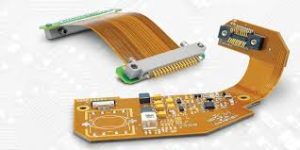lex circuit pcb differ from traditional rigid PCBs
Flexible circuit PCBs (flex PCBs) and traditional rigid PCBs are two distinct types of printed circuit boards used in a wide range of electronic applications. While both serve the primary function of providing electrical connections and mechanical support for electronic components, their differences in materials, design, applications, and performance characteristics make each suitable for specific purposes. Here’s a detailed look at how flex circuit PCBs differ from traditional rigid PCBs.
The most significant difference between flex circuit pcb and rigid PCBs lies in the materials used. Rigid PCBs are typically made from a fiberglass-reinforced epoxy resin, known as FR4, which provides a solid, inflexible structure. This rigidity is beneficial for applications where the board needs to maintain a fixed shape and position. In contrast, flex PCBs are made from flexible materials like polyimide or polyester films. These materials provide the necessary flexibility to bend, twist, and fold, allowing the PCB to fit into complex and confined spaces.
The design process for flex PCBs and rigid PCBs also differs significantly. Rigid PCBs have a layered construction that includes a substrate, copper layers, solder mask, and silkscreen. This structure is uniform and does not change. Flex PCBs, however, have a more complex design process due to their ability to bend and flex. They often include multiple flexible layers with adhesive between them, and they may require additional reinforcement in areas subject to mechanical stress. The ability to create three-dimensional shapes and paths with flex PCBs allows for more innovative and compact designs.

How do flex circuit pcb differ from traditional rigid PCBs?
The applications of flex PCBs and rigid PCBs are dictated by their respective properties. Rigid PCBs are commonly found in devices where space is not a constraint and where a sturdy, fixed board is beneficial, such as desktop computers, televisions, and other consumer electronics. Flex PCBs, on the other hand, are used in applications where space-saving, weight reduction, and the ability to conform to complex geometries are crucial. This includes smartphones, wearable devices, medical implants, and aerospace applications. Flex PCBs can be designed to fit into tight spaces and dynamic environments where traditional rigid PCBs would not be feasible.
Manufacturing flex PCBs is generally more complex than producing rigid PCBs. The flexible materials require careful handling to avoid damage during the manufacturing process. Additionally, the need to ensure that the flex PCB can withstand repeated bending without failure adds to the complexity. Techniques such as roll-to-roll processing are often used in the production of flex PCBs, which can increase manufacturing costs and time. Rigid PCBs, with their simpler manufacturing process and standardized production techniques, are generally easier and less expensive to produce.
Durability and reliability factors also differ between flex PCBs and rigid PCBs. Rigid PCBs provide a stable and robust platform that can withstand significant mechanical stress and environmental factors without deformation. However, they are prone to cracking if exposed to excessive mechanical flexing or vibration. Flex PCBs are designed to endure repetitive flexing and bending, but they can be susceptible to mechanical fatigue over time if not properly designed. Ensuring a proper bend radius and protecting high-stress areas are essential for maintaining the reliability of flex PCBs.
Thermal management is another area where flex and rigid PCBs differ. Rigid PCBs generally have better heat dissipation properties due to their thicker, more thermally conductive materials. Flex PCBs, made from thinner and less thermally conductive materials, can face challenges in managing heat. Effective thermal management strategies, such as incorporating thermal vias or heat sinks, are necessary to ensure that flex PCBs operate within safe temperature ranges, especially in high-power applications.
Cost is a critical factor in choosing between flex and rigid PCBs. Rigid PCBs are typically less expensive due to their simpler design and manufacturing processes. Flex PCBs, while offering significant advantages in terms of flexibility and space savings, are usually more costly to produce. This higher cost can be justified by the performance benefits and design possibilities they provide in specific applications.
In summary, flex circuit PCBs and traditional rigid PCBs differ fundamentally in their materials, design, applications, manufacturing processes, durability, thermal management, and cost. Each type of PCB has its own set of advantages and limitations, making them suitable for different types of electronic applications. Understanding these differences is crucial for engineers and designers to select the right type of PCB for their specific needs, ensuring optimal performance and reliability in their electronic devices.


